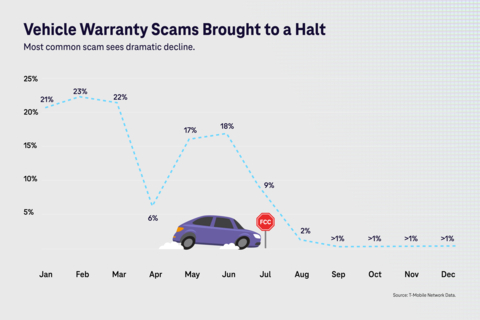T-Mobile Report: Customers Protected from More Than 40 Billion Scam Calls in 2022

What’s the news: The Un-carrier released its Scam and Robocall Report, sharing that T-Mobile’s Scam Shield identified or blocked 41.5 billion scam calls1 in 2022, a 75% increase from 2021. That’s a whopping 1,317 calls identified or blocked every second.

Vehicle Warranty Scam Calls brought to a Halt (Graphic: Business Wire)
Why it matters: Scammers and spammers are constantly evolving their attack methods as wireless providers and regulators continue to fight back. Industry wide, Americans lost an estimated $39.5B to phone scams in 2022.
Who it’s for: Anyone looking to better protect themselves and their families against scammers.
T-Mobile (NASDAQ: TMUS) today released its second annual Scam and Robocall Report, sharing new data looking back at 2022 to uncover insights related to scam, spam and robocall activity, as well as underscore how the Un-carrier helps to keep customers protected against these bad actors.
“At a time when scammers continue to get more creative and aggressive in their attempts, T-Mobile’s Scam Shield and advanced network protect our customers, identifying an average of 3.5 billion calls each month,” said Neville Ray, President of Technology, T-Mobile. “With scammers quickly evolving their tactics, we have to be just as fast at adapting our scam identification technology to fight back and keep customers protected.”
Scammer Behavior
Scammers are continuously upping their game to find new tactics and targets, with total robocall attempts up 75% from 2021 to 2022. Scam call volume reached an all-time high in January 2022 due to a surge of caller retries resulting from the introduction of a new return code (608) mandated by the Federal Communications Commission. Then, scam call volume declined steadily each month throughout the year, with occasional spikes during seasonal scam surges. Several factors contributed to this decline, including ongoing improvements to scam protection technology like T-Mobile’s Scam Shield, agility by mobile operators to implement new prevention tactics and regulator intervention.
Scam Shield is leading the way in keeping wireless customers safe from scams. In June, Verizon said they blocked 5B robocalls in the first half of the year. In that same period, T-Mobile’s Scam Shield blocked an impressive 25B.
Common Scam Tactics
Scammers followed similar patterns from years past, targeting consumers more heavily on weekdays vs. weekends and heavily ramping up activity during the two weeks before Christmas (hello package delivery scams!). But even scammers need a break, accounting for why major holidays like Christmas, New Year’s Eve, Easter, and 4th of July saw the lowest scam traffic dropping anywhere from 80-90%.
Vehicle warranty scams dominated the first half of the year, with T-Mobile’s Scam Shield blocking nearly double the amount of scam and robocalls in the front half of the year – averaging 4.2B blocked calls/month – compared to the back half – which averaged 2.7B blocked calls/month. In July, an unprecedented FCC cease and desist identified eight wireless providers – not T-Mobile – in violation of carrying these calls, which effectively brought vehicle warranty scams to a halt.
Scammers never stay away for long, so as vehicle warranty scams went into hibernation, health and insurance-related scams quickly rose up to take their place. To maximize their profits, these bad actors adapted their tactics to target key moments throughout the year. Back to school? That’s prime time for student loan fraudsters and Amazon scams. Tax season? IRS-related scams reigned supreme.
Target Regions/Demographics
Scammers hit some states harder than others, with Texas, Missouri, Nevada, South Carolina, and Oklahoma seeing the brunt of it, with victims often targeted by demographic and region. Texas received the highest volume of scam calls with insurance-related tactics targeting the uninsured and other unsuspecting victims. States with high senior populations like South Carolina are also key targets – imposters often mask as seniors’ aid staffers going after Medicare and other health-related scams.
Protect Yourself and Your Family
Built into the core of the network and free for all customers, T-Mobile’s leading patented Scam Shield technology provides the most powerful defense against scams. It updates protections every six minutes and identifies scam calls before they even reach a customer’s phone. When a threat is detected, customers either receive a “Scam Likely” warning or no disturbance at all by turning on Scam Block in the Scam Shield app or by dialing #662#.
The industry continues to see a rise in robotexts as a way to deceive unsuspecting victims. As scammers adapt and use new methods, T-Mobile continues to adapt as well, increasing investment in network level robotext protection.
T-Mobile and Metro by T-Mobile customers can download the Scam Shield app on the App Store or Google Play and have a dashboard at their fingertips for all Scam Shield anti-scam tools.
This report comes from T-Mobile’s analysis of internal Scam Shield data. Scam Shield is available to T-Mobile customers with qualifying service and a capable device. Turning on Scam Block might block calls you want, and Scam Block can be disabled at any time. For more information on Scam Shield, check out https://www.t-mobile.com/news/_admin/customers/scam-shield. Follow T-Mobile’s Official Twitter Newsroom @TMobileNews to stay up to date with the latest company news.
About T-Mobile
T-Mobile US, Inc. (NASDAQ: TMUS) is America’s supercharged Un-carrier, delivering an advanced 4G LTE and transformative nationwide 5G network that will offer reliable connectivity for all. T-Mobile’s customers benefit from its unmatched combination of value and quality, unwavering obsession with offering them the best possible service experience and undisputable drive for disruption that creates competition and innovation in wireless and beyond. Based in Bellevue, Wash., T-Mobile provides services through its subsidiaries and operates its flagship brands, T-Mobile, Metro by T-Mobile and Sprint. For more information please visit: https://www.t-mobile.com
1 Source: T-Mobile Network Data





